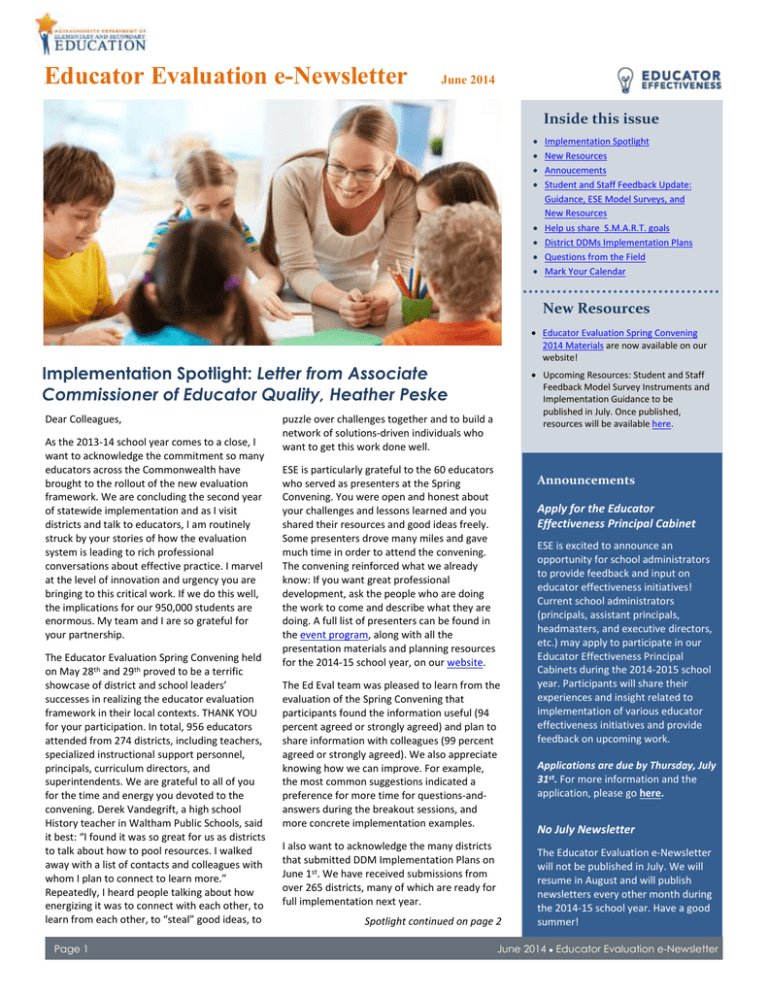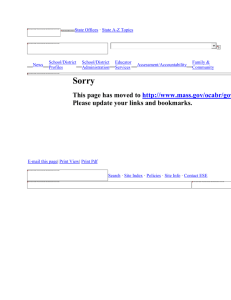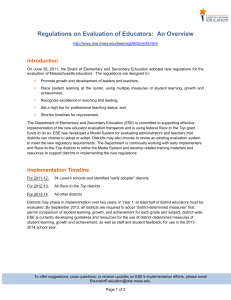2014 06
advertisement

Educator Evaluation e-Newsletter June 2014 Inside this issue Implementation Spotlight: Educator Evaluation with Teacher Teams is a Powerful Combination New Resources Educator Evaluation Spring Convening 2014 Materials are now available on our website! Implementation Spotlight: Letter from Associate Commissioner of Educator Quality, Heather Peske Dear Colleagues, As the 2013-14 school year comes to a close, I want to acknowledge the commitment so many educators across the Commonwealth have brought to the rollout of the new evaluation framework. We are concluding the second year of statewide implementation and as I visit districts and talk to educators, I am routinely struck by your stories of how the evaluation system is leading to rich professional conversations about effective practice. I marvel at the level of innovation and urgency you are bringing to this critical work. If we do this well, the implications for our 950,000 students are enormous. My team and I are so grateful for your partnership. The Educator Evaluation Spring Convening held on May 28th and 29th proved to be a terrific showcase of district and school leaders’ successes in realizing the educator evaluation framework in their local contexts. THANK YOU for your participation. In total, 956 educators attended from 274 districts, including teachers, specialized instructional support personnel, principals, curriculum directors, and superintendents. We are grateful to all of you for the time and energy you devoted to the convening. Derek Vandegrift, a high school History teacher in Waltham Public Schools, said it best: “I found it was so great for us as districts to talk about how to pool resources. I walked away with a list of contacts and colleagues with whom I plan to connect to learn more.” Repeatedly, I heard people talking about how energizing it was to connect with each other, to learn from each other, to “steal” good ideas, to Page 1 Implementation Spotlight New Resources Annoucements Student and Staff Feedback Update: Guidance, ESE Model Surveys, and New Resources Help us share S.M.A.R.T. goals District DDMs Implementation Plans Questions from the Field Mark Your Calendar Upcoming Resources: Student and Staff Feedback Model Survey Instruments and Implementation Guidance to be published in July. Once published, resources will be available here. puzzle over challenges together and to build a network of solutions-driven individuals who want to get this work done well. ESE is particularly grateful to the 60 educators who served as presenters at the Spring Convening. You were open and honest about your challenges and lessons learned and you shared their resources and good ideas freely. Some presenters drove many miles and gave much time in order to attend the convening. The convening reinforced what we already know: If you want great professional development, ask the people who are doing the work to come and describe what they are doing. A full list of presenters can be found in the event program, along with all the presentation materials and planning resources for the 2014-15 school year, on our website. Announcements Apply for the Educator Effectiveness Principal Cabinet The Ed Eval team was pleased to learn from the evaluation of the Spring Convening that participants found the information useful (94 percent agreed or strongly agreed) and plan to share information with colleagues (99 percent agreed or strongly agreed). We also appreciate knowing how we can improve. For example, the most common suggestions indicated a preference for more time for questions-andanswers during the breakout sessions, and more concrete implementation examples. I also want to acknowledge the many districts that submitted DDM Implementation Plans on June 1st. We have received submissions from over 265 districts, many of which are ready for full implementation next year. Spotlight continued on page 2 ESE is excited to announce an opportunity for school administrators to provide feedback and input on educator effectiveness initiatives! Current school administrators (principals, assistant principals, headmasters, and executive directors, etc.) may apply to participate in our Educator Effectiveness Principal Cabinets during the 2014-2015 school year. Participants will share their experiences and insight related to implementation of various educator effectiveness initiatives and provide feedback on upcoming work. Applications are due by Thursday, July 31st. For more information and the application, please go here. No July Newsletter The Educator Evaluation e-Newsletter will not be published in July. We will resume in August and will publish newsletters every other month during the 2014-15 school year. Have a good summer! June 2014 ● Educator Evaluation e-Newsletter Spotlight continued from page 1 We are in the process of reviewing these plans and will provide feedback to all districts by July 18th. You will read more about the DDM Implementation Plans later in this newsletter. As Sir Isaac Newton once said, “If I have seen further it is only by standing on the shoulders of giants.” THANKS again to all the giants out there who are doing the work of implementation. Please do not hesitate to reach out to ESE for additional support by emailing EducatorEvaluation@doe.mass.edu or by contacting me or the team directly. Best wishes for the summer. --Heather Student & Staff Feedback Update: Guidance, ESE Model Surveys, & New Resources Beginning next year, teachers and administrators will start collecting and using feedback about their practice as part of the 5-step cycle of evaluation. Feedback from one’s students or staff can be among the most meaningful types of feedback an educator receives— as relevant and resonant as feedback from a peer or supervisor. As districts move forward with this component of the evaluation process, we encourage educators, administrators, and students to embrace this as an opportunity for dialogue, and to apply the resulting feedback to the ongoing process of teaching and learning. In July, ESE will release Part VIII of the ESE Model System: Using Student and Staff Feedback in the Evaluation Process. Alongside this guidance will be key resources and strategies to assist districts in this process, including: ESE Model Surveys and Administration Protocols. A student feedback survey for grades 3-12 classroom teachers aligned to the Standards and Indicators of Effective Teaching, and a staff feedback survey for school-level leaders aligned to the Standards for Effective Administrative Leadership Practice, will be available. Districts may adopt or adapt these surveys, use a different survey, or choose alternative methods to collect feedback other than surveys. A select group of feedback items appropriately designed for students in grades K-2 will also be available. Administration protocols and suggestions for using the surveys in educator evaluation will also be released. Considerations for Collective Bargaining. Districts have a great deal of flexibility around the collection and use of feedback. As such, ESE is releasing a set of considerations for collective bargaining aligned to two key flexibilities: o Will feedback be collected via a district-wide vehicle, educator-specific methods, or a combination? o At which point(s) of the 5-step evaluation cycle will student and staff feedback be used? In order to support districts with strategic planning and implementation, the following tools and resources from the 2014 Spring Convening are now available: Strategic Planning Workbook for Implementing Student & Staff Feedback: includes graphic organizers to frame collaboration around the two key flexibilities districts have when considering how to implement student and staff feedback, as well as suggested next steps for implementation. Informational Resource Packet: includes a collection of ESE’s resources, such as a 2-page Quick Reference Guide on Student & Staff Feedback, the April 2014 Newsletter Spotlight on Student & Staff Feedback, Pilot Survey Project Summary, and Strategic Planning & Implementation Worksheet for districts. District DDMs Implementation Plans Congratulations to the over 250 school districts, charter schools, and vocational/technical schools that submitted DDM Implementation Plans. We commend the many districts that are ready to implement DDM in most grades and subjects. ESE recognizes that the work of identifying and developing DDMs for every educator is challenging, and we want to acknowledge the tremendous leadership and organization these districts have shown during this process. The Educator Evaluation team is currently reviewing extension requests, and will reply by July 18th. Completed plans and questions should be sent to EducatorEvaluation@doe.mass.edu. It is important to remember that the work is not finished! We will continue to share great examples of work that is happening across the Commonwealth to address critical questions about DDMs. Chelsea Public Schools has engaged teams of educators to develop growth measures that use rigorous parameters. Using a qualitative approach to Scoring and Parameter Setting, Chelsea’s educators determined initial guidelines for high, moderate, and low growth by reflecting on the amount of growth they would expect from different levels of performance on the assessments they are planning to implement. Marshfield Public Schools is using a different approach by setting parameters quantitatively, meaning their educators will look across student results and use the distribution of student scores on to inform the parameters for high, moderate, and low growth for each DDM. The MA School Nurse Organization, whose members were instrumental in assisting ESE in the development of the Implementation Brief on Indirect Measures, recently posted a host of new DDM resources on their website, including several draft example indirect measures. The Implementation Plans will provide the Educator Evaluation Team an excellent opportunity to identify and share promising practices like these across the state. Page 2 Help us share S.M.A.R.T. goals! As mentioned in last month’s newsletter, ESE would like to showcase S.M.A.R.T. student learning and professional practice goals developed and refined by MA educators. We are currently collecting S.M.A.R.T. goal examples and information about the goal development process from teachers, specialized instructional support personnel (SISP), and administrators across the Commonwealth to inform the development of S.M.A.R.T. goal resources. We encourage you to submit your student learning goals and/or professional practice goals by visiting this link before July 9th, 2014. June 2014 ● Educator Evaluation e-Newsletter Mark Your Calendar DDMs “Office Hours” We are still offering “office hours” and have sessions setup through July. District DDM Working Group members (1-2 per district) are invited to join Ed Eval team members at one of the DDMs “Office Hours” meetings. These meetings offer an opportunity to have questions answered and share implementation strategies with ESE’s DDM experts. Learn more about these sessions and how to RSVP here. Questions from the Field 1. Who is student and staff feedback meant to inform and serve? First and foremost, feedback is meant to inform and serve the educator about whom it is collected. Educators might use feedback data from students or staff to reflect back on the past school year, to inform their self-assessment or goal-setting for an upcoming school year, or as a way to monitor their own practice throughout the school year. In any case, feedback data and analysis will provide an important perspective to inform educators’ conversations with their evaluators. 2. Are principals required to be on one-year or two-year evaluation cycles? The regulations permit a two-year evaluation cycle for all experienced educators whose performance is rated Proficient or Exemplary and, starting in the 2016-2017 school year, whose impact on student learning is rated as Moderate or High (603 CMR 35.06). At the end of the first year, the educator receives a formative evaluation. Although not required, given the centrality of the principal’s role, the Model System for Principals strongly recommends a one-year evaluation cycle for all administrators, with a formative assessment at mid-cycle. For more information, please see Part V: Implementation Guide for Principal Evaluation. Questions or Comments are always welcome at EducatorEvaluation@doe.mass.edu Contact the Educator Evaluation Team Claire Abbott, Evaluation Training Program, Implementation Support, Student and Staff Feedback Susan Berglund, Evaluation Liaison to Level 3 and Level 4 Districts Kate Ducharme, Implementation Support, Student and Staff Feedback Kat Johnston, Communications, Peer Assistance & Review, Implementation Support Simone Lynch, Assistant Director, Office of Educator Policy, Preparation and Leadership Ron Noble, Evaluation Project Lead, District-Determined Measures, Student & Staff Feedback Craig Waterman, Assessment Coordinator, District-Determined Measures The Department of Elementary and Secondary Education is committed to preparing all students for success in the world that awaits them after high school. Whether you are a student, parent, educator, community leader, taxpayer, or other stakeholder interested in education, we invite you to join us in this endeavor. "To strengthen the Commonwealth's public education system so that every student is prepared to succeed in postsecondary education, compete in the global economy, and understand the rights and responsibilities of American citizens, and in so doing, to close all proficiency gaps." Page 3 Strengthen curriculum, instruction, and assessment Improve educator effectiveness Turn around the lowest performing districts and schools Use data and technology to support student performance To receive the monthly Educator Evaluation e-Newsletter in your inbox, please subscribe at http://www.surveygizmo.com/s3/1475008/Educator-Evaluation-e-Newsletter-Sign-Up. Page 3 June 2014 ● Educator Evaluation e-Newsletter







